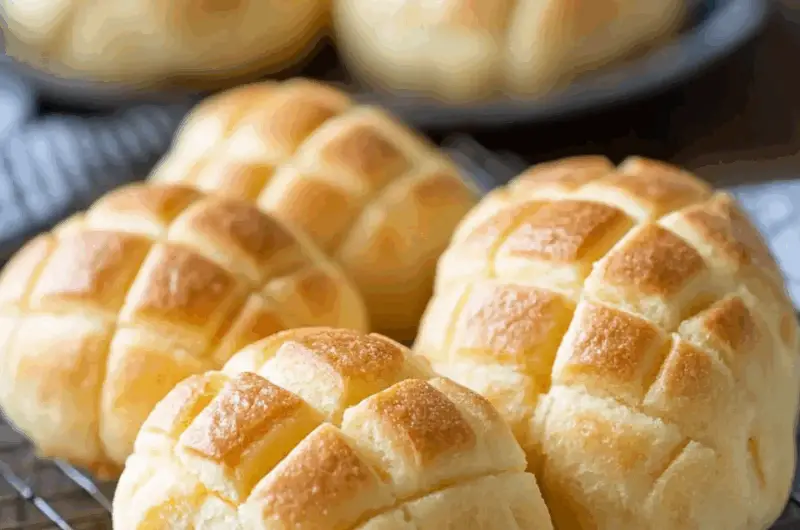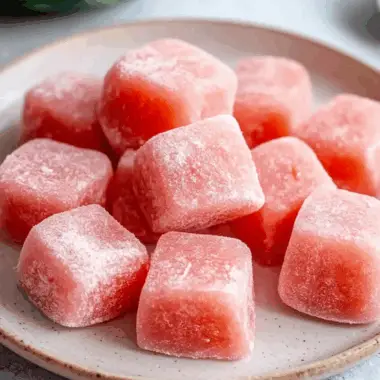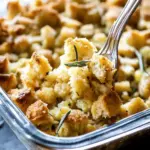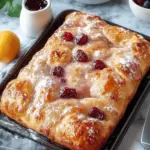Understanding the Structure of Melon Pan
The structure of Melon Pan consists of two main components: the bread dough and the biscuit dough topping. The bread dough is made with a combination of bread flour, cake flour, sugar, yeast, and butter, which provides the dough with a soft, airy texture once baked. The addition of cake flour helps achieve a light and tender crumb, which contrasts beautifully with the crunchy biscuit topping.
The biscuit dough is what gives the bread its signature crisp, sweet crust. Made with butter, sugar, and cake flour, it is rolled into balls and then placed on top of the risen bread dough. As the bread bakes, the biscuit dough hardens and forms a deliciously crunchy crust that is both sweet and slightly crumbly, adding a delightful contrast to the soft bread beneath.
Despite the simplicity of the ingredients, the resulting bread is an absolute treat, with layers of texture that make each bite enjoyable. The balance between the soft and sweet interior of the bread and the crisp, sugary topping makes Melon Pan a truly unique and satisfying experience.
The Bread Dough: Soft and Fluffy
The key to achieving that soft and fluffy texture in Melon Pan is the bread dough. The dough is made with bread flour, which gives it strength and elasticity, allowing it to rise well and maintain its shape. The addition of cake flour makes the crumb of the bread light and tender, resulting in the soft, airy texture that defines Melon Pan.
The dough also contains sugar, which adds a slight sweetness, and yeast, which is essential for making the dough rise. The butter incorporated into the dough enriches its flavor and adds a touch of richness. The dough is mixed and kneaded until it becomes smooth and elastic. It is then left to rise for 1-2 hours, during which the yeast works its magic, causing the dough to double in size. This fermentation process is essential for achieving the perfect texture, ensuring that the bread becomes light, fluffy, and slightly chewy when baked.
The Biscuit Dough: Sweet and Crunchy
The biscuit dough in Melon Pan serves two purposes: it provides the crunchy topping and creates the signature grid pattern on the bread. The biscuit dough is made with unsalted butter, sugar, cake flour, and baking powder. When mixed, this dough has a slightly crumbly texture that holds up well when placed on top of the bread dough.
Once the bread dough has risen, small portions of the biscuit dough are rolled into balls and placed over the bread. As the bread bakes, the biscuit dough spreads out and hardens into a golden-brown crust, with the grid pattern created by scoring the dough before baking. The result is a crunchy exterior that contrasts with the soft, fluffy bread beneath, creating a delightful combination of textures.
Shaping the Melon Pan: Achieving the Classic Look
To achieve the classic melon pan look, it’s important to shape the dough properly. After the bread dough has risen and been divided into small portions, each piece is rolled into a ball. The biscuit dough is then flattened and placed over the bread dough, covering it completely. The next step is to score the surface of the biscuit dough, creating a grid pattern that mimics the appearance of a melon.
The grid pattern is an essential feature of Melon Pan and gives the bread its signature look. It’s created by scoring the biscuit dough with a knife in a crisscross pattern, ensuring that the topping remains crisp and distinctive once the bread is baked. This step adds a touch of artistry to the bread, and the result is a visually appealing, fun-to-eat treat.
Baking: The Transformation into a Golden-Brown Treat
Once the dough is shaped, it is left to rise for a final time before baking. This final proof allows the bread to expand and become light and fluffy. The Melon Pan is baked at a relatively moderate temperature of 350°F (180°C) for about 13-15 minutes. During baking, the biscuit dough topping becomes golden brown and develops a crisp, crunchy texture. The result is a beautifully golden bread with a delicate contrast between the soft, fluffy interior and the crispy biscuit crust.
Baking the Melon Pan properly is essential to ensure that the biscuit topping doesn’t burn or dry out. It’s important to keep an eye on the bread as it bakes, checking for the perfect golden color on the crust. Once baked, the bread is removed from the oven and placed on a wire rack to cool, allowing the flavors and textures to set.
Serving and Enjoying Melon Pan
Melon Pan is best enjoyed fresh, while the biscuit crust is still crisp and the bread remains soft and warm. It’s the perfect accompaniment to a cup of green tea, or it can be enjoyed as a snack or breakfast treat on its own. While Melon Pan is delicious on its own, you can also serve it with various fillings such as red bean paste, chocolate, or even a dollop of whipped cream for an extra indulgence.
For a more traditional experience, Melon Pan is often enjoyed in Japan as part of morning coffee or tea. The combination of the sweet, soft bread and the slightly crunchy topping makes it a comforting and satisfying treat that can be enjoyed at any time of day.
Storing Melon Pan
Melon Pan is best eaten fresh, but it can also be stored for later enjoyment. To preserve the freshness and texture, store the bread in an airtight container at room temperature for up to 2-3 days. If you want to keep it for longer, you can freeze the bread and reheat it in the oven or microwave before serving. Reheating helps restore the bread’s soft texture while maintaining the crispness of the topping.
Nutritional Value of Melon Pan
Though Melon Pan is a sweet treat, it’s relatively moderate in calories compared to other pastries. Each serving contains around 309 kcal, with 49g of carbohydrates and 7g of protein. The bread is also a good source of iron and calcium, which are important for maintaining bone health and supporting various bodily functions. The fat content comes primarily from the butter used in both the bread and biscuit dough, adding richness and flavor. While the sugar content is moderate, it comes from natural sources like maple sugar and granulated sugar.
Conclusion
Melon Pan is a beloved Japanese confectionery that offers the perfect balance of soft, fluffy bread and a crunchy, sweet biscuit topping. Its distinctive grid pattern and delicious flavor make it an iconic treat in Japanese baking. Whether you’re enjoying it with a cup of tea or as a snack throughout the day, Melon Pan is sure to be a hit. The simple yet satisfying flavors make it an ideal treat to bake and share with family and friends. With its versatility and approachable recipe, Melon Pan is a fantastic addition to your baking repertoire, allowing you to bring a taste of Japan into your home.








